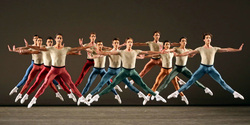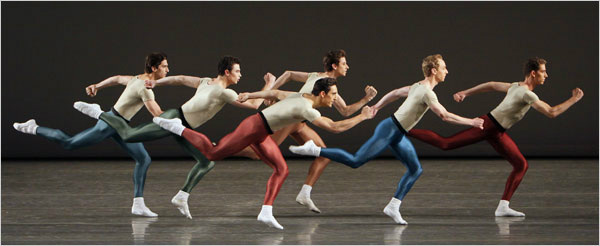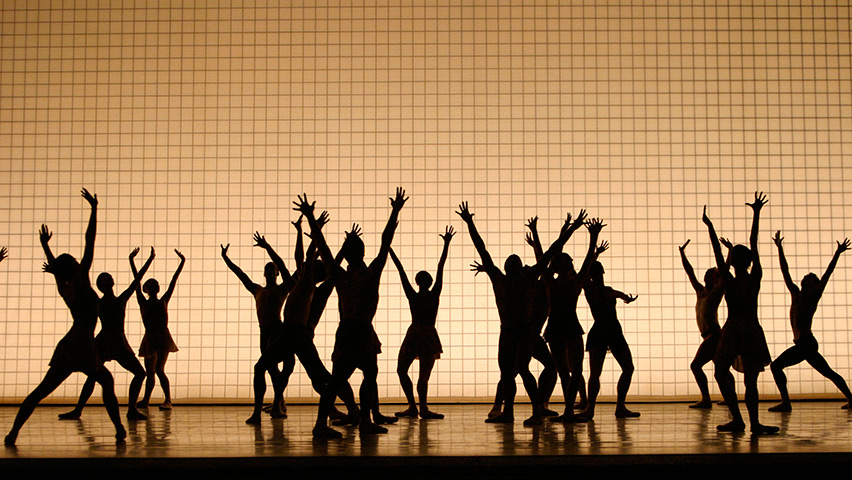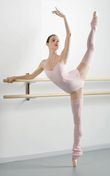The adrenaline-filled third movement of Glass is one of my all-time favorite pieces of choreography. It is set to the Act I: Scene I funeral music from Philip Glass’s 1984 opera Akhnaten (eponymously titled for the 18th Dynasty Egyptian Pharaoh). It may seem counterintuitive that music intended for a funeral could be invigorating, but to the ancient Egyptians funerals were not dolorous memorials but joyous ceremonies of rebirth into another realm. Glass Pieces premiered
 Photo by Paul Kolnik
Photo by Paul Kolnik The Akhnaten movement of Glass Pieces is primal and raw. There are no soloists in space-age garb in this section of the ballet—instead, the men and women of the corps (who up until this part of the ballet have hardly done any technical ballet dancing) dance difficult steps in complex patterns with a maximum of energy for 9 relentless minutes. The age of the gods is now over, or perhaps it hasn’t yet begun. This is the only movement of the ballet in which the corps dances over the underlying time signature of the score—often executing steps in sequences of five or ten counts when the music is metered in six and eight. They have either learned from the earlier alien/demigod soloists, or premeditated their erratic counterpoint. Either way, the cast here feels powerfully democratic, as if the dancers belong to a primeval band performing some communal rite of passage.
In stark contrast to the shadowy languor of Façades, Akhnaten commences as a lone man bursts onto a brightly lit stage to a strong drumbeat and runs a salutary circle at high speed around the perimeter. This first “Adam” figure was originally danced by Jock Soto (then in his sophomore year with the company). Once this man circles back to his starting point two more men appear out of the first stage-right wing to join him in a triangular wedge in nearly same entrance Robbins would make for Soto and two Shark gang members in West Side Story Suite twelve years later. The men continue to multiply and as they do they perform highly stylized tribal movements: with hands and feet frequently flexed, they beat their chests, roll on the ground, and nod their heads in regimented unison. In the rehearsal videos, Robbins exhorts the men to show guts and violence: “think Caesar if you have to,” he growls. This whole testosterone-filled opening section is an aggressive yet collectively articulated display of their talents. Each one must be a conqueror and a team player. These pseudo-warriors are a perfect example of the Darwinian concept of multilevel evolutionary selection. In this theory, humans as a species are eternally struggling with impulses towards egotistical self-preservation versus impulses towards the altruistic protection of the clan. The male corps in the third movement of Glass seems to be struggling with this uneasy legacy in every step they perform.
At the end of their section the men freeze suddenly with their arms up and bent ninety degrees at the elbow like goalposts—an Egyptian motif that Balanchine had sprinkled throughout Four Temperaments--which signals the arrival of the women. As the men halt, the heavy drums and brass cede prominence to some wispier string and woodwind flourishes as a line of women slinks onstage and through them. The women bob gently in horizontal processional from the back stage right wing (they basically reverse their chain from the second movement), their elbows are linked and their heads are turned in sharp profile in what appears to be an Egyptian frieze with a literal pulse. Less than a year later Robbins would employ lots of this same imagery in the all-female Antique Epigraphs set to Debussy.
As the line of women in Akhnaten attain the center of the stage, they slot in vertically downstage towards the audience in single file until all of a sudden they split apart to form a pyramid—the lone “Eve” figure at the head of the line spontaneously spawning a stage full of her own kind. The men back off the stage solemnly, and once alone, the women dance in a circle (classical symbol of the feminine) in contrast to the men’s more rigid, rectangular patterns. They employ the same flexed-wrist vocabulary as the men but they also perform leggier high kicks and hip gyrations. There is a pronounced sexiness to their dancing, but it is somehow coolly detached at the same time—rather like the women in Balanchine’s many black and white ballets. These women look both undeniably modern yet also like the women of an ancient era performing some maypole or fertility ritual. And that, in a nutshell, is Robbins’s real coup throughout this entire section of the ballet: his choreography transmits the illusion of modernity and antiquity simultaneously. Though he excised the Egyptian chorus, his dance depicts its meaning.
When the men start to filter back onstage in a section the dancers call “apples and oranges” this dichotomy is glaringly apparent. The men enter in sharply zigzagging trios with one hand on a hip and the other out front and flexed as they walk stiffly with turned-in feet and deeply bent knees. Each trio resembles geometric petroglyph trains along a temple wall as well as figures in early video games like Pac Man or Centipede. Robbins’s meticulous studies of Ancient Egyptian and Greek dances, though evident throughout the ballet, are especially apparent in this section—as when each dancer faces another of the opposite dancer and jumps and kicks their own rear with one foot playfully in a direct quote from the comedic kordax dance from about 480 B.C.E. Dance historian Lillian B. Lawler writes that the kordax was “lascivious, ignoble, obscene, and that its distinguishing feature was a lewd rotation of the abdomen and buttocks, often with the feet held close together.” That exact move is performed by the women in the ballet, but it would also work at a nightclub.
Soon the groups integrate completely and the whole company makes byzantine concentric patterns all over the stage. Two opposing circles form within the same grid and pass through each other in opposite directions until the music builds and the dancers jump and spin in unison in the same clockwise direction. In the concluding seconds of the ballet, this giant human wheel breaks off into spokes and the dancers spin out from the circle’s hollow nucleus, only to face each other at the last moment to strike a pose on the final note of the music. For a second before the fall of the curtain they stand arms upraised, heads thrown back as if in praise of some imagined, absentee deity above; or maybe in deference towards their worthy peers around the ring. This last moment is exquisitely charged—it could either represent a question mark or an exclamation point, a death or a birth (as was Glass’s intent of course).
There is a palpable sense of relief in the audience as the sturdy beat of the music drops out and the swirling eddies made by the corps stop on a dime. To heighten the effect, on the last note of the music the lighting changes and the whole stage is thrown into the same silhouette as the corps women in the second movement of the ballet. One can link this to the DNA imagery I proffered in Façades—as if Robbins is showing us an x-ray at the last minute to assert that what keeps the circle of life going lies deep within us on a microscopic level. The abrupt ending of Glass Pieces is like a bomb going off: after the slow build of energy has accumulated tremendous force, it simply explodes. It is almost as if the dancers are swirling subatomic particles—perhaps those purposefully blasted together in the Large Hadron Collider at CERN today, or those coalescing haphazardly in the moments leading up to the Big Bang so many millennia ago.
It is surely no accident that the ballet ends in a circle. The circle is, quite literally, the basis of all choreography. In etymological terms choreia--the ancient Greek from which we take the root for the word choreography—translates to “circle dance.” The most basic forms of group organization take the shape of a circle (think of how we arrange little kids in preschool lessons), and every culture has a circular dance of some sort. In Glass, Robbins quotes the ancient, spherical dithyramb. The circle formation is also the basis of civilization—our earliest ancestors gathered together around fires which spurred the earliest forms of group cooperation. Robbins overtly references the cyclical nature of all life in Akhnaten, and throughout Glass Pieces he deftly highlights the fact that even the most modern of urban pedestrians darting through traffic have more in common with ritualistic ancient dynasties—and in all likelihood, the spacemen of the distant future—than they probably realize.
Glass Pieces is a ballet that astounds because all of its steps can be seen from many distinct perspectives—past, present, and future, within and without the human form. Robbins exhibits for us, as Proust writes in Le Temps Retrouvé, “cette notion du temps incorporé, des années passées non séparées de nous” (“this notion of time embodied, of years past but not separated from us”). Balanchine died on April 30, 1983. Glass premiered not two weeks later on May 12 and boosted the grieving company. After Wendy floated off for the last time in Glass on Friday, Russell and the rest of the corps danced their hearts out in Akhnaten. My sadness morphed into hope.



 RSS Feed
RSS Feed